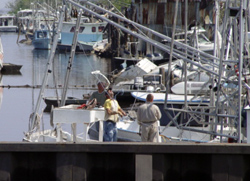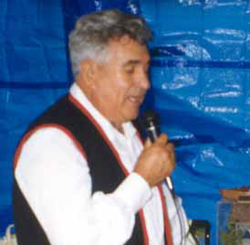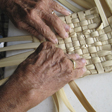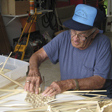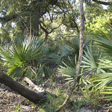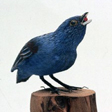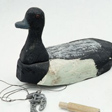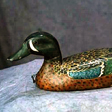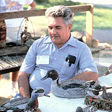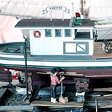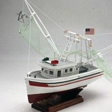The Evolution of the Isleño Identity
By Sara-Ann Harris
Hurricane Katrina made landfall in southeast Louisiana on August 29, 2005. In the aftermath of the hurricane, Louisiana Department of Wildlife and Fisheries (LDWF) staff organized trips to the coastal parishes to try to better understand what had happened and to generate a plan for recovery assistance.
In St. Bernard Parish, they were hoping to assist seafood communities. LDWF staff interviewed fishermen at Violet Canal, a safer inland location where fishermen stored their boats during storms. The fishermen were checking over their boats and making repairs to motors.
This essay is a comment on what the lower St. Bernard Parish seafood communities, the Isleños, lost that day at the hand of natural forces -- and how they endured in spite of it.
History of Los Isleños
The Isleños hailed from the Canary Islands, an archipelago south of Spain. At the time of the American Revolution, when Spain held dominion over Louisiana, she developed a major plan to populate the new province. Spain provided Canary Islanders, among others, safe passage across the Atlantic. In Louisiana, they received land, farm tools, a house, and a monthly stipend. From 1778 - 1783, approximately 2,000 Spanish Canary Islanders arrived in New Orleans: men, women, children, and infants.
Louisiana Governor Bernardo de Galvez arranged for their settlement. He positioned the newcomers at four strategic sites surrounding the port of New Orleans to defend Spain's Gulf trade routes from the English. Moving counter-clockwise around the city, the villages were Amite, Donaldsonville, Barataria, and St. Bernard Village. The governor planned for the islanders to sustain themselves as small farmers.
Cultivating the rich soil of the Delta, the Canary Islanders produced vegetable and fruit crops. Life was good, however, families also faced challenges posed by annual flooding of the Mississippi River, storm surges from the Gulf of Mexico, pestilence and disease. Three of the four villages blended with other cultural groups that settled in the area. This left St. Bernard Village as the single Spanish Canary Island settlement in Louisiana that retained the Spanish language and in which the Spanish Canary Island culture dominated.
As the plantation economy came into its own in Louisiana, sugar planters began to purchase the riverfront property from the Spanish Canary Islanders. During this era, family farms and sugar plantations thrived in St. Bernard Parish.
Isleño Identity Emerges
As the sugar trade developed, some Canary Island families moved eastward from St. Bernard Village to an even more remote location. First, they settled the villages of Delacroix, Wood Lake and Reggio along Bayou Terre aux Boeuf. Later they formed the communities of Yscloskey, Shell Beach, and Hopedale on Bayou La Loutre. At these sites the settlers identified themselves as Los Isleños or The Islanders. And they called Delacroix, the heart of their culture, The Island.
The Isleño identity was built on the Spanish cultural traditions and a coastal life of hunting and fishing. Isleños cooked Spanish Canary Island dishes, spoke their native language, and kept Spanish singing and folk dancing alive. Their folk arts included lace making, furniture building, wood carving of song birds and ducks, and palmetto weaving, among others. They also learned the crafts necessary to manage the hunting and fishing trades, including boat building, paddle carving, and inventing and reinventing all kinds of gear.
To survive in the wetlands required the Isleños to strengthen their family ties and community reciprocity. There was no doubt in their minds that living in isolation meant that each of them was needed to solve day-to-day challenges, such as building homes and feeding everyone. It was these values that kept them sailing when harsh elements threatened to sink the boat.
Most importantly, as hunters and fishermen the Isleños were called upon to adapt to the natural forces of south Louisiana. The ocean tides, cycles of the moon, winds, and water salinity contributed to production of abundant, high-quality seafood and game. However, from year to year, these forces changed. And so, as generous as the delta could be, it could also be niggardly. Living on the coast was always a gamble.
In addition to dealing with inconsistency, the Isleños lived with the fact that each fall during hurricane season, natural forces were poised to wipe them out altogether. Living with nature's rich blessings and brutal hardships sculpted the Isleño identity.
In the early days, there was a sailboat in front of every palmetto-thatched home. The wetlanders worked only at nearby forests and bays and simply caught enough to feed their families; it was a subsistence economy.
Louisiana Seafood Goes To Market
By the 1850s, folks began catching a surplus, more than what was needed to sustain their families. They evolved into Mom and Pop Traders. That is, they started to run small family businesses. They became better organized and had regular routes to fishing and hunting grounds, as well as nearby markets, the largest being New Orleans. This was the first time the Isleños sold their catch. They grew more secure in their identity not just as hunters and fishermen, but as providers for themselves and the city of New Orleans.
But as always, they were exposed to seasonal Gulf of Mexico storms. Hurricanes bore down on the Louisiana coast frequently, even yearly, especially during the months of August, September and October. In 1893, one of the deadliest hurricanes to ever make landfall in Louisiana struck Jefferson Parish, an area west of St. Bernard on the other side of New Orleans. It is estimated that 1,000 to 2,000 people died in the Cheniere Caminada Hurricane or the Great October Storm. It is likely this catastrophe impacted other coastal communities, including the Isleños.
What bolstered Isleños after these horrific events was their core identity. Strong family ties, community reciprocity, and their cultural traditions brought them back from the brink, so to speak. Their folk arts, crafts of their trades, and adaptations for hunting and fishing staid their mettle.
Spanish Louisiana Singing Tradition
One of the most striking Isleño cultural traditions was décima singing. The Isleños inherited a Spanish singing tradition that has been traced back to the 15th century. In Delacroix, they sang together after a day's work, to celebrate weddings, or to entertain themselves after a big meal at a friend's home.
None of these songs were written down and the singers did not necessarily read music. Dr. Samuel Armistead, author of The Spanish Tradition in Louisiana, explained that the Isleños composed variants of Spanish style songs and called them décimas. Indications are that the popularity of this singing and composing tradition was heightened in the 1900s.
Dr. Armistead discussed the Isleño décimas in terms of four Spanish song-writing forms: (1) the poetic commentary on daily events, (2) the romantic scandal, (3) the tall tale, and (4) the story that ribs a neighbor about a foible.
“La Pesca del Cameron“ / “The Shrimper” is a good example of both a tall tale and a décima that ribs someone about a shortcoming. Boy Molero was a conceited young shrimper. He was competitive - always claiming to out-do everyone else, whether it was with the best crew, the best catch, or the best boat. A few lines follow.
La Pesca del Cameron
A las cuatro la mañana.
La compaña Boy presente.
El otro día a las se?,
no habia caba barca gente.
Cuando Boy salió calando a esa mancha camarón,
‘tuvo un me y siete dia pálcontrá'l otro calón.
Cuando Boy siende las luse y en el sentro del mar,
se queda todo alumbrá o como Caye'l Canal.
Boy mandó haser una barca, con una buena largura:
¡Cuando la prova ‘sté aquí, que la popa en Chepitula!
The Shrimper
It was four in the morning.
All Boy's crew standing by.
At six the next day,
they still weren't all on board.
When Boy went out fishing for that school of shrimp,
it took him a month and seven days to bring together his nets.
When Boy turns on the lights out in the middle of the sea,
everything lights up, as bright as Canal Street.
Boy had a boat built and it was pretty long:
when the bow is here in Delacroix, the stern'll be in Chepitula!
In Spanish, of course, the lyrics rhyme. Note the references to New Orleans in the song: Canal Street is the Central Business District and Chepitula is Tchoupitoulas Street, which is 30 miles from Delacroix.
Décimas were an excellent manifestation of the Isleño identity, in that they embraced both Spanish culture and the fishing way of life. Beginning in 1900, décima singing was the height of the Saturday night dance hall experience.
Dance Hall Era, 1900-1940s
At the turn of the 20th century good fortune visited the Isleños. When the trend to wear fur escalated among Americans, Mom and Pop Traders profited tremendously. They caught record numbers of mink, beaver, and especially muskrat. The Isleños prospered unlike they ever had before. With extra income, they raised their standard of living and, thus, may be aptly called Modern Mom and Pop Traders. They replaced sail power with gasoline powered motors, drove trucks instead of mule carts, and built more homes of wood rather than thatched palmettos. Most important to their cultural lives, they built dance halls in each village. The halls cultivated décima singing, dancing, traditional cooking, and speaking Spanish. Dance halls also strengthened their survival skills: strong family ties and community reciprocity. The Isleño experience of their identity was heightened during the Dance Hall Era.
Every Saturday night, parents, children, teenagers, grandparents, infants - everyone - went to the dance. Dance contests were open to all ages and proud winners showed off their prizes. New Orleans bands played at the dance halls until midnight, then the community sat down for a meal.
Home cooked Spanish dishes like caldos (vegetable stews), paella (seafood and rice), stuffed merliton, and rice pudding were popular, as were Louisiana dishes like seafood gumbo, roasted duck, and red fish courtbouillon. The tremendous availability of fresh food in the Mississippi Delta was a blessing the Isleños did not take for granted.
After dinner the singing began. The décimeros might go after anyone: an unfaithful aunt or a neighbor who carelessly busted his boat motor. No one knew who the décimero would rib. Everybody took great delight in the décimas. And so it would go, week to week, from Isleño town to Isleño town.
To negotiate life in the outside world, the Isleños learned French in the 19th century and then English. However, on Saturday nights at the dance halls, everyone spoke Spanish, sang in Spanish, and told jokes in Spanish. Their language was a source of pride.
Outside of the dance halls, life repeated a familiar pattern: hardship at the hand of natural forces and the struggle to recover. The Mississippi River Flood churned into south Louisiana in 1927 and the Isleños were faced with major destruction of the landscape, loss of life, and property. The damage to these communities was intensified by the diversion of flood waters into lower St. Bernard Parish, a tactical move to preserve the city of New Orleans.
It took years for the Isleños to recover after the Great Flood. Some families moved to northern St. Bernard Parish and took day jobs. Beginning in the 1930s, some signed on for more reliable employment in the new oil and gas sector. About the same time, roads and public education introduced many new people to lower St. Bernard -- and many more Isleños to the outside world.
Those who returned after the flood began hunting, trapping, fishing and shrimping again. They also rebuilt the dance halls, where cultural traditions thrived through the 1940s. Today, Isleños tell stories about dance halls in the 1950's, but by then, they explain, Saturday nights were not necessarily family events or exclusively for Spanish-speakers. Nor did they feature décima singing or midnight Spanish/Louisiana dinners. The Isleño identity was fading.
Isleño Identity Slips Away, 1950s - 1975
The evolution of the Isleño way of life in the 1950s saw a more decisive break with home made crafts of the trades, such as wooden boat building and net knitting. Steel hulled boats, monofilament nets, and hydraulic power replaced hand-crafted gear and muscle power.
Modernization disrupted family ties. Men and boys could now work on the water for weeks at a time. They returned home for short breaks and headed out again. Sitting down together for a Spanish/Louisiana family meal became the exception rather then the rule.
A life based on coastal natural forces was undermined by navigation interests and oil and gas operations that required digging extensive channels through the marsh. This disturbed the ecology and displaced some of the wildlife and fisheries there.
When Hurricane Betsy stuck in 1965, Isleño community reciprocity and strong family ties were wearing thin. The storm devastation was immense. After Betsy, it was, once again, a difficult road back in lower St. Bernard. Eventually, the large shrimp and oyster trade families returned.
Some people still spoke Spanish, but only at home. Some would sing a décima, but only if asked. Home cooks were still famous for Spanish Louisiana hot dishes, but there were fewer and fewer family Sunday dinners. The Dance Hall Era had faded in the late 1940s and Betsy blew down the last hall. After Betsy, the daily experience in lower St. Bernard was barely recognizable as Isleño.
Isleño Revitalization, 1976 - 2005
In the 1970s, Frank Fernandez, the St. Bernard Parish historian, emerged as an advocate of revitalizing Isleño customs. While traditional daily life could not be resurrected, the food, language and songs could be given renewed visibility. Folk art, as well as crafts of the trades, could be displayed and better appreciated. In these ways, the Isleños could build an awareness of their culture. It was a revitalization movement.
The first meeting of revitalization movement was in Delacroix in 1976 where the Isleños planned a festival. It featured local foods, folk arts and crafts of their trades. In all likelihood the décimeros sang and individual local musicians played. It was well received and the Isleños held other festivals periodically.
The Isleños responded well to Frank's leadership. A host of resourceful community members were supported financially by parish political leaders and the Canary Island government itself. The Isleños began vacationing in the Canary Islands and participating in singing and dancing festivals there.
As their relationship with the Canary Islanders solidified, choruses and dance troupes from the homeland began performing in St. Bernard. In approximately 1990, the festival and the visiting talent converged as one event and it was called the Annual Isleño Fiesta.
In the 1980s, two major clubs evolved out of the original group meeting in Delacroix. Los Isleños Heritage and Cultural Society managed an historic family farm home in St. Bernard Village as an office and staging area. The Isleño Society added other farm homes and a bar/grocery store from the town of Toca. Los Isleños Heritage and Cultural Society Complex, or Los Isleños Complex, as it is referred to today, was the site of many popular cultural programs.
The Isleños also formed the Canary Island Descendants Association (CIDA) in the 1980s with a center in Caernarvon. Among other activities, members had 18th century folk attire custom-made, learned traditional folk dances and performed around the state. The crafts of the hunting, fishing, and trapping trades were displayed for audiences who had never seen pirogues, fur pelt stretchers, or cotton cast nets before.
The impressive range of revitalization activities were created, planned, and executed by the committed members of these two groups and other generous volunteers. The Annual Isleño Fiesta, produced by the Isleños Society, evolved as the highlight of the movement. At the Fiesta, St. Bernard Parish folks prepared foods with their Spanish Canary Island visitors. Folk artists displayed beautiful carved wooden ducks and shrimp boats, palmetto woven pieces, quilts, and furniture. And, of course, people came from considerable distances to enjoy the talented Canary Island choruses and dance troupes. The Fiesta was a huge draw every year.
After approximately 200 years, the identity of Isleños in Delacroix, Reggio, Wood Lake, Ycloskey, Shell Beach and Hopdale had morphed into that of a generic modern Louisiana fishing family. Fortunately, the revitalization movement succeeded in effectively paying homage to the distinctive early Isleño way of life.
Revitalization: Singing Tradition, 1976 - 2005
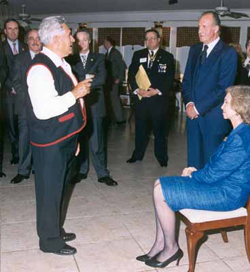
Like other cultural traditions of the Isleños, décima singing lapsed into obscurity after Hurricane Betsy. However, it wasn't long before the Isleño décimeros captured the imagination of Spanish Canary Island scholars. The researchers originally came to Delacroix to visit Serephine Perez. They documented the songs he sang from 15th century Spain. They also recorded original songs composed by Serephine and his brother Paul, as well as Irvan and Allen, their sons respectively. Irvan took the researchers from the Canary Islands on driving tours of lower St. Bernard Parish to visit with and record other décimeros, men and women, at their homes.
During this revitalization of the décima Irvan performed at the New Orleans Jazz and Heritage Festival, the French Quarter Festival, the Northwestern State University Folk Festival in Natchitoches, as well as national folk heritage festivals in the Mid-Atlantic States including Washington, D.C.
In 1990, the Smithsonian Institute invited Irvan to Carnegie Hall, where he performed in Folk Masters: The Traditional Music in America Series. Then, in 1991, Irvan was awarded a National Heritage Fellowship from the National Endowment for the Arts.
In 2001, “The Majesty of Spain: Royal Collections from the Museo del Prado and Patrimonio Nacional” was exhibited at the Mississippi Arts Pavilion in downtown Jackson. It was billed as the largest array of Spanish royal treasures ever exhibited in North America.
As guests of the state of Mississippi, the CIDA dance troupe performed at a day-long educational program. Irvan was granted an audience with King Juan Carlos and Queen Sophia of Spain and performed in his melodious lilting voice. Media from around the globe attended and publicized the events.
Given Irvan's talent and his willingness to represent the Isleños, there seemed to be no end to the opportunities for enhancing the visibility of the Isleño décima.
Two décimas by Irvan Perez were featured in the publication Swapping Stories: Folk Tales from Louisiana, #153 “La vida de un jaibero”/ “The Life of a Crab Fisherman” and #154 “La vuelta del marido”/ “The Husband's Return”
His décimas are also featured in the Louisiana Voices lesson plan on historical legends.
Post Katrina Isleños: Where did they Go? Who would come back? 2005 - 2007
On August 29, 2005, Hurricane Katrina growled into Louisiana. Afterwards, it looked like something evil had been unleashed in the wetlands. The Isleño fishing trade appeared washed out to sea. In a sense, the natural forces which had been sometimes benevolent and sometimes seemingly demonic, finally manifested with a fierceness making Life at the End of the World, as the Isleños referred to their villages, no longer sustainable.
Post Katrina life in lower St. Bernard Parish was chaotic. It was unclear who was where, who would return and when. Surveying Isleños required multiple drives into the collapsed bayou world. Yet, even with such a happenstance approach, the surveys began to tell a story. The following people helped connect the dots to form a picture of where people were.
Lionel Serigné
Lionel Serigné was born in Delacroix and still owned what could be reconstructed as a boat dock there. He was one of the very few who returned after Hurricane Katrina. Lionel estimated that 350 people lived on The Island before the storm. He approximated that 60 of those former residents spoke Spanish. He said the hurricane forced everyone to evacuate up river some 15 miles, where it was safer behind the protection levee - or completely out of state.
Allen Perez
Allen Perez was also born in Delacroix. He said, all of the homes there except one were demolished. Allen said that about seven families returned -- all fishermen (shrimpers or crabbers). He counted off the people on his fingers: “Rodney Morales, Rocky Morales, Nicholas Campo, Philip Lopez, Paul Serigné, Eloise Melerine, and Lionel Serigné. I might have missed a couple of them.” That is, maybe, ten people and their spouses out of 350 had returned by early 2007.
Even as houses, docks, and boats were asunder, Allen seemed to take things in stride. After Hurricane Betsy in 1965, Allen had rebuilt his house himself. He sank heavy steel rods into the ground and installed concrete around them as piers. There was no sign of that house after Katrina.
At 74 years old, Allen planned to spend the rest of his life in Delacroix with his wife Pat. But like many other Isleño fishermen, he decided to sell his shrimp boat, The Solid Gold. If people returned, he said, there was a chance that some variation of the seafood trade would continue. But, of course, the traditional way of life itself, the Isleño identity, was long gone. Allen explained, “This generation is nothing like we were. Oh, they are completely different -- in every way. But, well, it's just their way. You have to accept it.”
Jeanette Alphonso
Jeanette Alphonso was born in Delacroix. She lived in Chalmette before the storm. Following Katrina, she and her husband, Manuel, helped her father rebuild his house in Poydras and lived with him and other family members in trailer homes provided by FEMA.
“There will never be a community there [Delacroix] again,” Jeanette said. “People will still fish and shrimp from The Island [Delacroix], but they won't live there.”
Many fishermen still docked their boats in front of their property in Delacroix. They now came and went from their new homes - behind the protection levee. Along the bayou there were approximately 100 shrimping and crabbing boats and a couple of oyster luggers. There were also about 100 sports fishing boats docked there. Recreational fishing in lower St. Bernard is legendary. Before Hurricane Katrina, a growing number of recreational fishermen, often locally called “sports,” were building camps there.
Cecilia “Celie” Robin
Cecilia “Celie” Robin was born in New Orleans and moved to Yscloskey after marrying Charles Robin, a shrimper and wood carver. They lived there before the storm and evacuated to Violet. Charles passed away six months after the storm.
She sounded disgruntled when she talked about the community returning. “Oh, I don't know [if anybody else will come back]! A lot of sports are moving in. I'm not selling my land!” she said. “But really,” she conceded, “It's all up to the younger people.”
Several Isleños said that they did what they have always done after a storm. They relocated to higher ground within St. Bernard. Celie said, “Most of the people from Delacroix Island -- they moved in one section [of Violet]; and the people from Yscloskey -- they moved in two different sections. So, we know everybody around here because they once lived down the road [as neighbors].”
Irvan Perez
Irvan Perez was born in Delacroix. He relocated to Poydras with his wife and family after Hurricane Betsy. He was a trapper, décima singer, and wooden duck carver. He evacuated to Mississippi during Hurricane Katrina, then returned to Poydras where he and his daughter were rebuilding his home.
Irvan talked about how many elders had passed away. He was referring not just to the losses during Katrina, but to the people who died after the storm, seemingly because of the trauma of the storm. It was a deeply sorrowful time. Respected members of the community were lost including Jessie Bourg and Charles Robin, two wooden model boat builders; Linda Robin Gray, the grant writer and community contact with the Canary Islands; Antonia Gonzales, a founding member of one of the Isleño clubs; patriarch Blackie Campo and shrimper Roy Campo. And then -- on January 8, 2008 -- Irvan Perez himself died. Words cannot express the loss felt by his family and friends.
Donna Mumfrey
Donna Mumfrey was born in New Orleans and lived in Chalmette before Katrina. She has been invalueable for decades in the revitalization of folk dancing and crafts of the trades. She now lives in Braithewaite in Plaquemines Parish.
Donna said sorrowfully, “Katrina was like a death sentence.” Prior to the storm as special events director for the Canary Island Descendants Association, Donna had assembled a list of Isleños who excelled in crafts and dancing. She looked over her list and noted who had passed away: “Three-quarters of these people have died.”
There were a lot of funerals at St. Bernard Church. They drew people back from wherever they'd relocated. And though it is a time for grieving, the funerals also took on the feeling of reunions.
“A funeral is almost like a get-together,” Donna said. “People come in from Mississippi and everywhere else for the funerals. They ask one another 'What about so and so?' They go elsewhere and, boy, they come back. They are away, but they do not want to be.”
Celie said that Sunday mass at St. Bernard Church was a particularly energized gathering of the people living in middle and lower St. Bernard Parish. San Pedro, the church built after Betsy, was torn down by Katrina and the archdiocese decided that the risk was too steep to rebuild yet again.
Survey Wrap-Up
The survey commented on the lamentable loss of life during this time. It revealed that virtually all of the Isleño fishing families evacuated from lower St.Bernard before Hurricane Katrina, all of the homes except one were demolished, and most families were not likely to return. Of those who continued their seafood trades, many lived behind the protection levee 15 miles up river. It also indicated that the Spanish language was a thing of the past and sports were continuing to build fishing camps in St. Bernard.
Fortunately, there were stirrings of a sense of community among the Isleños. This, it seems, was to bode well for Revitalization II, the next wave of activities to commemorate the traditional Isleño identity.
Revitalization II, 2006-
The viability and authenticity of the Louisiana Isleño identity was impressive up until Hurricane Betsy. Their identity as Isleños at The End of the World evoked the respect of people who made the trip down Bayou Terre aux Boeuf or Bayou La Loutre.
Their revitalization movement beginning in 1976 was strong and effective. The Isleños brought an appreciation for their traditions, folk arts, and the crafs of their trades to the next generation and to a much wider audience. Slapped down one more time by Hurricane Katrina, the Isleños hoped for the best as they patched together the next incarnation of their revitalization program.
Cultural Tradition: Décima Singing
The chance of performances by décimeros after the Hurricane Katrina appeared shaky. The singing gained wide popularity in the 1980s due to CIDA leadership and Irvan Perez's talent. After Katrina, it is reasonable to conclude that though there were other Spanish speakers still in St. Bernard, Irvan and Allen were the only living décimeros. However, if Allen continued singing décimas, it's likely that it was only during personal reverie.
When Irvan was asked to perform, he acquiesced with his usual charm and wit. But this return of the décimero was short-lived, as Irvan passed away in 2008. John Rankin, a Loyola University professor of the fundamentals of string instruments, was one of many people who grieved the loss. He spoke of the man with veneration in his voice. “He was a figurehead. So accomplished. So confident about people. His death is enormous.” It was enormous; the curtain came down on the last Isleño décima performer.
Cultural Tradition: Saturday Night Dance
The Saturday night dance tradition including décima singing, Spanish/Isleño dinner, and speaking in Spanish fell away in the late 1940s. It was not revived. However, after Katrina, Edween Nunez, a man who grew up on Saturday night dances, reconstituted a variation on the custom.
After the storm, Edween relocated from lower St. Bernard to higher ground, like many Isleños. In the town of Violet at De Pope Tavern and Boat Launch, at 100 years of age Edween kicked off a Saturday night dance.
“Oh yea. I didn't dance all the time,” said Edween, meaning it had been many years since the dance hall days. “You see I hadn't been dancing much lately, but here [De Pope's Tavern] I dance every week end.”
Just as everyone did at the turn of the 20th century dance halls, Edween's favorites were the waltz and the fox trot. Here's Johnny, the band at De Pope's, picked the waltz up and began playing it on Saturday nights. Edween said, “Now everybody likes it! Yea.” He shook his head affirmatively.
Edween passed away a year and a half later, after his 102nd birthday.
Staging Grounds
The Isleño Society Complex and the CIDA site were not spared by Hurricane Katrina. At the Isleno Complex, the historic farmers' houses were smashed and the multipurpose building was destroyed beyond repair. CIDA's headquarters - a fishing family home -- sat in water for a fatal length of time. Termite infestation was overtaking the structure.
Bill de Marigny Hyland, director of Los Isleños Complex, left no stone unturned in his efforts to bring the Complex back. Everyone who could assist, did. Eugene Cizek, architectural preservationist, oversaw the restoration of the historic buildings to assure their integrity.
Like other community events in the region that rose up and came back, the Annual Isleños Fiesta was staged just six months after the storm. The Isleño Complex was still being rebuilt, so the Fiesta was held in Chalmette. It was tremendous. Then in spring 2007, the Isleños held their Fiesta at the refurbished Isleños Complex in St. Bernard Village. Clearly, the revitalization program was back on safe ground.
Folk Arts: Palmetto Weaving
With the help of folk artists like Richard Gonzales, the revitalization of Isleño folk arts continued after Hurricane Katrina. Richard excelled at palmetto weaving. He was born in Delacroix in 1927, one of seven brothers. His father Severo taught all seven boys many methods of utilizing the palmetto, a common understory plant or shrub with long pointed leaves.
During his childhood on Delacroix Island, there was an expanse of forest where the boys collected palmettos. The boys learned to make baskets for the Easter season. They soaked the leaves after collecting them and carefully wove them into forms. Their parents filled the baskets with Easter surprises. The technique for a smooth and finished basket was all in the hands.
As the boys grew up, they got away from palmetto weaving. When the seafood trade got tough, Richard moved up to Poydras and worked for Kaiser Aluminum, like many men who needed a more reliable paycheck. But around 20 years ago when he retired, Richard got back to weaving palmettos by hand.
The utilitarian uses of palmetto included assembling trappers' huts. Richard recounted the time when he, his cousin, and a few friends built a three-room thatched hut in the woods. He said, “We cut poles. We stick them in the ground. We take the vines that grows on them trees, the little bitty vines. We used to take that and tie the palmettos on and tie the poles altogether. You could say, it was a palmetto house. They had three rooms to it. And that's when we were kids!”
Richard has been invited to many Louisiana fairs and festivals to demonstrate his weaving techniques learned so long ago from his father. One time, during the French Quarter Festival, a visitor was looking at his baskets on display. She took a special interest in one of the smaller ones.
“I made a little bitty basket,” Richard said. “A lady there asked me what kind of machine I used to build a basket like that. I say, 'Right here.' [He smiles and holds up his hands.] That's the only machine I got lady.”
Isleños at the New Orleans Jazz and Heritage Festival
As people of southeast Louisiana picked up the pieces of their lives, it was important that church fairs, college theatrical commemoratives, traditional festivals, music events, even Mardi Gras got up and running. It was uplifting for those who remained and returned to meet at these longstanding celebrations.
Since 1991, the New Orleans Jazz and Heritage Festival had invited Isleño folk artists to demonstrate their skills and display their wares in the Folklife Village. After Katrina in 2006, JazzFest opened their gates for their usual spring event—and the Isleños were there. The presence of both the Fest and the Isleños started small, but grew to full capacity by the next year.
Folk Arts at the Fest: Wood Carving/Ducks
Duck hunters of the early Isleño days carved ducks out of wood and set them out on ponds to attract ducks flying south for the winter. Before 1937, when the federal government set limits on duck hunting, it was legal to market hunt, or harvest ducks and sell them at the market. Seraphine Perez was a successful market hunter and his son Irvan hunted with him during his childhood and into his young adult years. At ten years old, Irvan carved duck decoys, as they were called.
Much later, after raising his own family, Irvan picked up his interest in wood carving again. By then, the craft had developed into an art. The artwork was not intended for hunting at all, but for the fireplace mantle. The subtlety of Irvan's technique and the lifelike quality of his pieces were exceptional.
Irvan displayed his creations annually at New Orleans Jazz and Heritage Festival. He was invited to other festivals locally, regionally, and then nationally. After Hurricane Katrina, Irvan returned to Jazz Fest with his ducks. Then, even after he passed away, his family continued to share his lovely bayou folk art at the Fest.
Folk Arts at the Fest: Wood Carving/Fishing Boats
Charles Robin took up carving miniature wooden boats when he retired from a life of oyster farming and crabbing in lower St. Bernard. Robin was respected for his art and had been invited to display at the Folklife Village at Jazz Fest for many years. Charles was proud to say that each of his art pieces was modeled after an actual Isleño fishing vessel and penned with its original name.
Like so many Isleño Katrina stories, this one takes an ugly turn. The Robin home and boat were lost to flooding; the model boats in an upstairs workshop were battered. Hundreds of tiny parts broke off and settled in sludge. And after the storm Charles passed away.
Also like many Isleño Katrina stories, this one has a silver lining. Charles Robin, III, son of the master craftsman, took on the daunting task of reassembling the broken boats. He is a professional boat builder and also does custom millwork. Bringing his considerable skills to the job, Charles, III spent many evenings to fulfill a promise he had made to his father to pass the folk art on to the next generation. One way he does this is by displaying his father's work at Jazz Fest.
Folk Arts at the Fest: Home Remedies
When Cecilia “Celie” Robin was employed by the St. Bernard Council on Aging, she visited the elderly and the infirmed to take their blood pressure and comfort them. During this time, she learned about home remedies the Isleños had passed down for generations: salt on poison ivy rashes, cobwebs on cuts, and a ritual involving a glass of water and turning one way and then the other for a headache.
Celie recorded the remedies and Los Isleños Heritage and Cultural Society published a booklet for the edification of all interested persons. Celie is a well known spokesperson for the community and has been very active in the revitalization movement. Her presence at Jazz Fest before and after the storm has always been appreciated.
Photo:
Cecilia Robin shares Isleño traditions with visitors to the New Orleans Jazz and Heritage Festival in 2010. Photo: Maida Owens.
Conclusion
The Isleño identity was a complex blending of Spanish Canary Island cultural traditions and the kinship, resourcefulness, artistry, and craftsmanship that defined a hunting and fishing culture in coastal Louisiana. For approximately 200 years, the communities of lower St. Bernard Parish embraced this identity, even as it was being modified by more sophisticated hunting and fishing technology, alterations to the marsh ecology, and natural disasters. Arguably, the Isleño identity had its last moments at the hand of Hurricane Betsy in 1965.
The Isleño cultural revitalization movement, following Betsy, lasted for nearly thirty years and grew into a huge success. Hurricane Katrina robbed the community of leaders of their movement, folk artists, and bearers of traditions. Louisianans may never again enjoy the live performance of a décimero or watch a master Isleño woodcarver demonstrate the art of sculpting marsh ducks or family fishing boats.
Fortunately, even though it took losses, the movement successfully recovered. There are Isleño elders, their families, and Isleños of today's generation who continue to bring Isleño Louisiana cooking, Spanish wines and cheeses, wood carving, furniture-making, palmetto weaving, and dramatic storytelling, among other customs to huge audiences at fairs and festivals. The Annual Isleño Fiesta continues to feature traditional 18th century Canary Island choruses and dance troupes. Every year, Fiesta-goers are compelled to join the dancers and imbibe in the traditional foods and spirits. And so, the Isleño spirit lives on and Isleño customs are appreciated by an ever-widening circle of enthusiasts.


